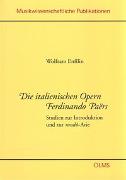- Start
- Die italienischen Opern Fernando Paërs
Die italienischen Opern Fernando Paërs
Angebote / Angebote:
In ogni caso il catalogo, completato nelle ultime pagine dall' utilissimo incipitario testuale die brani, è redatto con grande cura e precisione, e costituisce un fondamentale strumento di riferimento per chiunque corrà occuparsi di Paer e dell' ancora oscuro periodo di cuil il maestro parmigiano fu un vero protagonista." (Giuliano Castellani, Il Saggiotore Musicale 2006 )
Ferdinando Paër (1771-1839), einer der gefeiertsten und erfolgreichsten Opernkomponisten am Ende des 18. und zu Beginn des 19. Jahrhunderts, verschwand nach seinem Tod sehr schnell aus dem Bewußtsein der musikalischen Öffentlichkeit. In musikgeschichtlichen Abhandlungen fand sein Name zumeist nur Erwähnung im Zusammenhang mit Beethovens Fidelio (aufgrund der Komposition einer Leonora, deren Inhalt auf dieselbe französische opéra-comique zurückgeht), Rossinis Aufstieg und Wirken in Paris (beide leiteten gemeinsam das Théâtre italien von 1824-1826) sowie als Komponist des Maître de chapelle, einer opéra-comique, die in Paris das gesamte 19. Jahrhundert hindurch kontinuierlich gespielt wurde.
Die vorliegende erste Monographie zum Schaffen Paërs behandelt seine italienischen Opern (1792-1816). Die Analyse konzentriert sich dabei auf zwei für die Opernentwicklung dieser Epoche äußerst wichtigen formalen Bestandteile, die lange Zeit in der Forschung vernachlässigt wurden: Die Introduktion sowie das rondò als Sonderfall der zweisätzigen Arie.
Im Vordergrund bei der Untersuchung von Paërs Introduktionen stehen Gattungsspezifika (opera buffa, opera semiseria und opera seria), die Exposition der jeweiligen Opernhandlung sowie das Verhältnis von textlicher Exposition und musikalischer Introduktion.
Die Analyse seiner rondò-Arien wird bestimmt von der Fragestellung, inwieweit sich textliche Strukturen in der musikalischen Form widerspiegeln und in welchem Maße bei der existierenden rondò-Typik individuelle musikalische Lösungen Paërs festzustellen sind. Vor dem Hintergrund zahlreicher rondò-Arien seiner Zeitgenossen wird eine Entwicklungslinie vom einsätzigen Ritornellrondo zum zweisätzigen rondò aufgezeichnet, das wiederum als Ausgangspunkt für die im 19. Jahrhundert weitverbreitete Standardform cantabile-cabaletta dient. Ein kurzer biographischer Abriß rundet diese Studie ab.
***
Ferdinando Paër (1771-1839), one of the most celebrated and successful opera composers of the late 18th and early 19th centuries, quickly disappeared from the minds of the musical public after his death. In studies of music history his name is usually mentioned only in connection with Beethoven's Fidelio (due to his composition of a Leonora based on the same French opéra-comique) or with Rossini's rise and work in Paris (the two men jointly managed the Théâtre italien from 1824-1826), or else he is remembered as the composer of the Maître de chapelle, an opéra-comique which continued to be performed in Paris throughout the 19th century.
This first full-length study of Paër's work examines his Italian operas (1792-1816). The analysis focuses on two formal elements which were of the utmost importance in the development of opera during this period but which have long been neglected by scholars: the introduction and the rondò as a particular form in the two-part aria.
In the foreground of the study of Paër's introductions are genre-specific elements (opera buffa, opera semiseria and opera seria), the exposition of a given opera's action, and the relationship between the textual exposition and the musical introduction.
The analysis of Paër's rondò-arias is based on the questions of how far textual structures are reflected in the musical form and to what extent we can identify Paër's own musical solutions in the context of the existing type of rondò form. Against the background of numerous rondò arias by Paër's contemporaries, a development is traced from the single-subject ritornello to the two-part rondò, which in its turn became the starting-point for the cantabile-cabaletta, the widespread standard form in the 19th century. A short biographical sketch completes the study.
Lieferbar in ca. 5-10 Arbeitstagen
